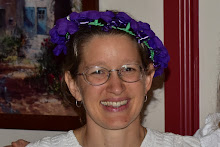I wasn't planning on teaching the kids about binary numbers yet, but Ari and I ended up doing it yesterday. It was Barry Simon's fault.
Here's how it happened. We were discussing CBS (Community Bible Study, which the kids and I attend on Thursday mornings) at lunch time. E is never able to remember the story he has heard at CBS - I'm not sure if he just isn't aware that they're telling a story, or if he's decided that forgetting the story is easier than telling us about it. In any case, this led to a discussion of good and bad teachers. And Ari and I started talking about Barry Simon.
When I was a frosh (insert quavery voice) at Caltech, Barry Simon taught Math 1a. He was brilliant, I'm told. So brilliant that there's no way he could stoop to teaching the elementary concept of epsilon-delta proofs in such a way that the average Caltech freshman could understand them. Instead, he found special cases and exceptions, and talked exclusively about those. At least, I think that's what he did. I never really understood anything in Barry Simon's class. I spent one evening determined to understand the topic of the next day's lecture before it happened, so I studied the subject over and over until I was sure I grasped it. I entered the class knowing how it worked; I left class hopelessly confused. The joke was that one day Barry Simon would teach us to breathe, and we'd all suffocate.
As Ari and I discussed his teaching style, I wondered aloud how he would teach a 6-year-old how to add with regrouping. I figured the first thing he would do would be to convert 28+37 into binary, without mentioning that he was doing anything of the sort, or explaining to the 6-year-old that such a thing as binary even existed. I was unsure of whether P was ready to learn binary, but when Ari was done laughing, he decided to prove me wrong.
This actually turned out to be a lot of fun. Ari labeled a piece of paper with columns for 8s, 4s, 2s, and 1s, and we explained that in binary you're only allowed to use 1s and 0s. Ari started by having P identify the values of 0000 (B's age), 0100 (E's age), 0110 (P's age), and 0111. E then wrote a few 1s and 0s at random, and it ended up being 00101. P's ability to easily figure out that that was 5 made me wonder if I really could show her how to add in binary without and with regrouping. We started out with 1+2=3 (01+10=11), and then I explained how 2+3 (10+11) had 2 in the 2s place, meaning 4, so we had to write a 1 in the 4s place instead: 10+11=101. She thought this was really neat - and I suspect that it'll help her grasp regrouping more easily when adding in base 10.
All of a sudden, I started wondering: What does the Fibonacci sequence look like in binary? What about skip counting - what patterns are there? How do you do long division in binary? I can imagine myself forgetting about what I'm trying to teach P and starting to explore this sort of question myself during our math lesson, leaving her hopelessly confused. Please say it ain't so: Could I ever turn into Barry Simon?
Subscribe to:
Post Comments (Atom)


Ha! Good for you! Dan put my 29th birthday on my cake in binary. :-)
ReplyDelete"It was Barry Simon's fault"....
ReplyDeleteHaha!!! So true :). I nearly failed Math 1a, and then they had mercy on me and gave me an "E", provided I could pass a later class taught by Mason Porter (undergrad at the time). Mason made much more sense than Barry Simon, and hence, I eventually graduated :).
Sounds like you guys taught P in a way she understood--hence you will NOT turn into Barry Simon. :)
I love reading your blog! :)
Just wanted to add...what an appropriate day for introducing binary!
ReplyDelete10/01/10 :).
Ha! Glad I was in .9!
ReplyDelete